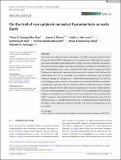On the trail of iron uptake in ancestral Cyanobacteria on early Earth
Abstract
Cyanobacteria oxygenated Earth's atmosphere ~2.4 billion years ago, during the Great Oxygenation Event (GOE), through oxygenic photosynthesis. Their high iron requirement was presumably met by high levels of Fe(II) in the anoxic Archean environment. We found that many deeply branching Cyanobacteria, including two Gloeobacter and four Pseudanabaena spp., cannot synthesize the Fe(II) specific transporter, FeoB. Phylogenetic and relaxed molecular clock analyses find evidence that FeoB and the Fe(III) transporters, cFTR1 and FutB, were present in Proterozoic, but not earlier Archaean lineages of Cyanobacteria. Furthermore Pseudanabaena sp. PCC7367, an early diverging marine, benthic strain grown under simulated Archean conditions, constitutively expressed cftr1, even after the addition of Fe(II). Our genetic profiling suggests that, prior to the GOE, ancestral Cyanobacteria may have utilized alternative metal iron transporters such as ZIP, NRAMP, or FicI, and possibly also scavenged exogenous siderophore bound Fe(III), as they only acquired the necessary Fe(II) and Fe(III) transporters during the Proterozoic. Given that Cyanobacteria arose 3.3-3.6 billion years ago, it is possible that limitations in iron uptake may have contributed to the delay in their expansion during the Archean, and hence the oxygenation of the early Earth.
Citation
Enzingmüller-Bleyl , T C , Boden , J S , Herrmann , A J , Ebel , K W , Sánchez-Baracaldo , P , Frankenberg-Dinkel , N & Gehringer , M M 2022 , ' On the trail of iron uptake in ancestral Cyanobacteria on early Earth ' , Geobiology , vol. Early View . https://doi.org/10.1111/gbi.12515
Publication
Geobiology
Status
Peer reviewed
ISSN
1472-4677Type
Journal article
Description
Joanne Boden and Tristan Enzingmuller-Bleyl contributed equally to this work.Collections
Items in the St Andrews Research Repository are protected by copyright, with all rights reserved, unless otherwise indicated.

